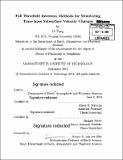| dc.contributor.advisor | Alison E. Malcolm and Michael Fehler. | en_US |
| dc.contributor.author | Yang, Di, Ph. D. Massachusetts Institute of Technology | en_US |
| dc.contributor.other | Massachusetts Institute of Technology. Department of Earth, Atmospheric, and Planetary Sciences. | en_US |
| dc.date.accessioned | 2015-02-25T17:09:59Z | |
| dc.date.available | 2015-02-25T17:09:59Z | |
| dc.date.copyright | 2014 | en_US |
| dc.date.issued | 2014 | en_US |
| dc.identifier.uri | http://hdl.handle.net/1721.1/95558 | |
| dc.description | Thesis: Ph. D. in Geophysics, Massachusetts Institute of Technology, Department of Earth, Atmospheric, and Planetary Sciences, 2014. | en_US |
| dc.description | Cataloged from PDF version of thesis. | en_US |
| dc.description | Includes bibliographical references (pages 243-252). | en_US |
| dc.description.abstract | Quantitative measurements of seismic velocity changes from time-lapse seismic experiments provide dynamic information about the subsurface that improves the understanding of the geology and reservoir properties. In this thesis, we propose to achieve the quantitative analysis using full wavefield inversion methods which are robust in complex geology. We developed several methodologies in both the data domain and image domain to handle different time-lapse seismic acquisitions. In the data domain, we implemented double-difference waveform inversion (DDWI), and investigated its robustness and feasibility with realistic acquisition non-repeatabilities. Well-repeated time-lapse surveys from Valhall in the North Sea are used to compare DDWI and conventional time-lapse full waveform inversion (FWI) schemes. An FWI approach that uses the baseline and monitor datasets in an alternating manner is proposed to handle time-lapse surveys without restrictions on geometry repeatability, and to provide an uncertainty analysis on the time-lapse changes. In the image domain, we propose time-lapse image domain wavefield tomography (IDWT) that inverts for P- and S-wave velocity changes by matching baseline and monitor images produced with small offset reflection surveys. This method is robust to survey geometry non-repeatabilities and baseline velocity errors. A low velocity zone caused by local CO2 injections in SACROC, West Texas is found by IDWT with time-lapse walkaway vertical seismic profile surveys. The methods in this thesis combined, allow for an integrated velocity inversion to achieve high-resolution subsurface monitoring with various types of acquisitions in complex geology. | en_US |
| dc.description.statementofresponsibility | by Di Yang. | en_US |
| dc.format.extent | 252 pages | en_US |
| dc.language.iso | eng | en_US |
| dc.publisher | Massachusetts Institute of Technology | en_US |
| dc.rights | M.I.T. theses are protected by copyright. They may be viewed from this source for any purpose, but reproduction or distribution in any format is prohibited without written permission. See provided URL for inquiries about permission. | en_US |
| dc.rights.uri | http://dspace.mit.edu/handle/1721.1/7582 | en_US |
| dc.subject | Earth, Atmospheric, and Planetary Sciences. | en_US |
| dc.title | Full wavefield inversion methods for monitoring time-lapse subsurface velocity changes | en_US |
| dc.type | Thesis | en_US |
| dc.description.degree | Ph. D. in Geophysics | en_US |
| dc.contributor.department | Massachusetts Institute of Technology. Department of Earth, Atmospheric, and Planetary Sciences | |
| dc.identifier.oclc | 903533766 | en_US |
